
Cilicia is a geographical region in southern Anatolia in Turkey, extending inland from the northeastern coasts of the Mediterranean Sea. Cilicia has a population ranging over six million, concentrated mostly at the Cilicia plain. The region includes the provinces of Mersin, Adana, Osmaniye, along with parts of Hatay and Antalya.

Cyrus the Younger was an Achaemenid prince and general. He ruled as satrap of Lydia and Ionia from 408 to 401 BC. Son of Darius II and Parysatis, he died in 401 BC in battle during a failed attempt to oust his elder brother, Artaxerxes II, from the Persian throne.

Tissaphernes was a Persian soldier and statesman, Satrap of Lydia and Ionia. His life is mostly known from the works of Thucydides and Xenophon. According to Ctesias, he was the son of Hidarnes III and therefore, the great grandson of Hydarnes, one of the six conspirators who had supported the rise of Darius the Great.

A satrap was a governor of the provinces of the ancient Median and Achaemenid Empires and in several of their successors, such as in the Sasanian Empire and the Hellenistic empires.
Leo III Armenian: Լեւոն Գ, Levon III) (occasionally numbered Leo IV; was a young king of the Armenian Kingdom of Cilicia, ruling from 1303 or 1305 to 1307, along with his uncle Hethum II. A member of the House of Lampron, he was the son of Thoros III of Armenia and Margaret of Lusignan, who was the daughter of King Hugh III of Cyprus.

Ruben I,, also Roupen I or Rupen I, was the first lord of Armenian Cilicia. He declared the independence of Cilicia from the Byzantine Empire, thus formally founding the beginning of Armenian rule there. The Roupenian dynasty ruled Cilician Armenia until 1219.

Datames, also known as Tarkamuwa, was an Iranian military leader, who served as the governor (satrap) of the Achaemenid satrapy of Cappadocia from the 380s BC to 362 BC. A Carian by birth, he was the son of Camissares by a Paphlagonian mother. His father being satrap of Cilicia under Artaxerxes II, and high in the favour of that monarch, Datames became one of the king's bodyguards; and having in this capacity distinguished himself in the war against the Cadusii, was appointed to succeed his father in the government of his province. Here he distinguished himself both by his military abilities and his zeal in the service of the king; and reduced to subjection two officials who had revolted from Artaxerxes, Thyus, governor of Paphlagonia, and Aspis of Cataonia.
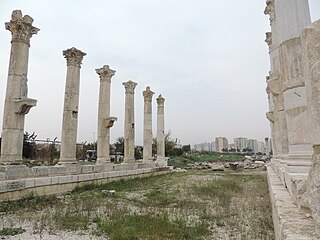
Soli, often rendered Soli/Pompeiopolis, was an ancient city and port in Cilicia, 11 km west of Mersin in present-day Turkey.

Media is a region of north-western Iran, best known for having been the political and cultural base of the Medes. During the Achaemenid period, it comprised present-day Azerbaijan, Iranian Kurdistan and western Tabaristan. As a satrapy under Achaemenid rule, it would eventually encompass a wider region, stretching to southern Dagestan in the north. However, after the wars of Alexander the Great, the northern parts were separated due to the Partition of Babylon and became known as Atropatene, while the remaining region became known as Lesser Media.
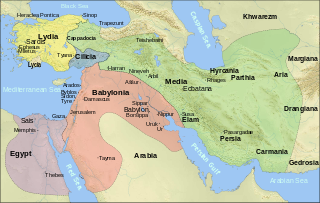
The Kingdom of Cilicia was an independent state that existed from 612 BC to 549 BC. The state was governed by the Syennesis dynasty, possibly from Greeks that moved into Cilicia towards the end of the Bronze Age. Prior to and after the independent kingdom, the Syennesis dynasty ruled Cilicia as autonomous state under the Neo-Assyrian Empire, Achaemenid Empire and the Alexander the Great’s Empire.
Cilician pirates dominated the Mediterranean Sea from the 2nd century BC until their suppression by Pompey in 67–66 BC. Because there were notorious pirate strongholds in Cilicia, on the southern coast of Asia Minor, the term "Cilician" was long used to generically refer to any pirates in the Mediterranean.

The Satrapy of Lydia, known as Sparda in Old Persian, was an administrative province (satrapy) of the Achaemenid Empire, located in the ancient kingdom of Lydia, with Sardis as its capital.
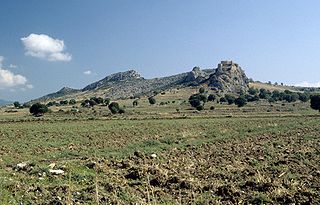
Castabala, also known as Hieropolis and Hierapolis was a city in Cilicia, near the Ceyhan River.
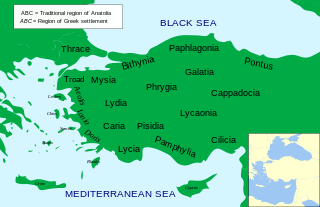
Classical Anatolia is Anatolia during Classical Antiquity. Early in that period, Anatolia was divided into several Iron Age kingdoms, most notably Lydia in the west, Phrygia in the center and Urartu in the east. Anatolia fell under Achaemenid Persian rule c. 550 BC. In the aftermath of the Greco-Persian Wars, all of Anatolia remained under Persian control except for the Aegean coast, which was incorporated in the Delian League in the 470s BC. Alexander the Great finally wrested control of the whole region from Persia in the 330s BC. After Alexander's death, his conquests were split amongst several of his trusted generals, but were under constant threat of invasion from both the Gauls and other powerful rulers in Pergamon, Pontus, and Egypt.

Mongol Armenia or Ilkhanid Armenia refers to the period in which both Armenia and the Armenian Kingdom of Cilicia became tributary and vassal to the Mongol Empire in the 1230s. Armenia and Cilicia remained under Mongol influence until around 1335.

The Thirty-first Dynasty of Egypt, also known as the Second Egyptian Satrapy, was effectively a satrapy of the Achaemenid Persian Empire between 343 BC to 332 BC. It was founded by Artaxerxes III, the King of Persia, after his reconquest of Egypt and subsequent crowning as Pharaoh of Egypt, and was disestablished upon the conquest of Egypt by Alexander the Great.
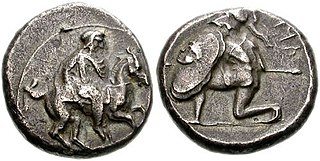
Syennesis, also Syennesis III was a ruler of ancient Cilicia in the 5th century BCE.

Cilicia was one of the most important regions of the Middle East throughout history, who hosted the Hittite, Hellenistic, Roman, Armenian, and Islamic civilizations. Historically many people considered it as a part of the Levant, and during what is called the Rashidun Caliphate, much of its area was titled with the arabic name "Ath-Thugur As-Shamiyya"-carrying the meaning Levantine outskirts.


















